Gardeners often become confused as to whether vegetables should be planted from seed or transplants. Transplants insure a reliable plant population and, usually in the spring, produce earlier than crops planted from seed. In the spring, certain vegetable crops such as eggplant, onions (bulb), pepper, sweet potatoes and tomatoes should be transplanted from commercially-grown transplants or transplants gardeners can grow from seed. Information on how to grow your own transplants can be found at:
http://aggie-horticulture.tamu.edu/vegetable/lubbock/seedling.pdf
However, plants which have been established by sowing seed directly into the soil often have a stronger, deeper root system which consequently grows a healthier, larger, more productive plant than those grown by using transplants.
TIMING and VARIETIAL SELECTION determines the success or failure of directly-seeded crops and transplanted vegetables.
-with-same-seed_Small.jpg) |
First tomato seed planting in front is poor germination compared to the planting a week later (top seedlings) with same seed because of environmental adversities.
|
TIMING (see: http://aggie-horticulture.tamu.edu/archives/parsons/fallgarden/falldirect.html)
| Fall Direct Seeding Guide |
|---|
| Tomato and Pepper: |
| Hill Country |
San Antonio |
South of San Antonio |
| June 15 |
July 1 |
July 10 |
| Lettuce: |
| Hill Country |
San Antonio |
South of San Antonio |
| September 15 |
October 10 |
November 1 |
Direct-seed zinnias, purslane, portulaca and American (Large-flowered) marigold in July (see Mari-Mums for the fall at:
http://aggie-horticulture.tamu.edu/archives/parsons/earthkind/ekgarden.pdf
VARIETAL SELECTION (see: http://plantanswers.com/Articles/GuideToRecVegVars.asp)
Over the years, major advancements have been made in the area of production reliability. Reliable production has been made possible by new hybrid varieties of vegetables which are earlier producers of larger yields. These hybrids are disease resistant as well as vigorous growers.
Unfortunately, there are only a few vegetable seed companies left in the world, and they are eliminating the older, Texas-proven varieties in favor of new, "improved' hybrids which have a significantly higher seed cost. Once eliminated from the market because of seed non-availability, these old-timers which have been trialed-and-proven and loved by Texans have been designated *heirloom* (âr'lōōm') varieties, i.e., *A heirloom fruit or vegetable is a cultivar of a vegetable or fruit that is open-pollinated and is not grown widely for commercial purposes. An heirloom often exhibits a distinctive characteristic such as superior flavor or unusual coloration.* Varieties which are now being increased and are for sale can be found at: http://plantanswers.com/parsons_preferred_seed.htm
Success in seeding vegetable crops depends on factors such as (1) planting technique, (2) soil moisture and (3) fertility.
(1) PLANTING TECHNIQUE
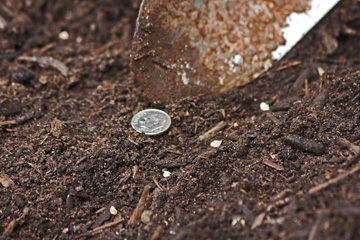
Sow the seeds on top of the bed and gently rake them in; a general rule of thumb is to cover the seed approximately 2 to 3 times their widest measurement. Gardeners should plant seed thickly with the intention of thinning to an optimum stand later.
Seeds planted too deep often do not emerge adequately to produce a desirable stand.
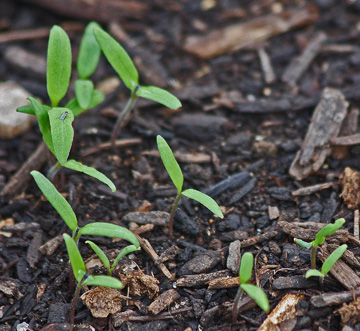
For example, pepper seedlings are easily obstructed in their upward thrust and fail to emerge if planted too deep. Because most vegetable seeds are relatively small, they do not have sufficient emergence strength to push through deep soil. Some gardeners often plant a *stronger sprouting* seed such as radish to help a *weaker
sprouting* seed (such as pepper) break through a hardened soil surface. Seeds planted too shallow often dry out too rapidly causing poor germination - this is why it is vitally important to keep recently seeded areas moist -- ESPECIALLY in the late summer and fall - until germination occurs.
Planting too much seed or too few seed can cause problems.
If too few seed or seed with poor germination (old, weakened seed sprout poorly and produce a weak, sickly seedling and plant) are planted, it will necessitate replanting and cause the loss of time and
possibly decrease overall yields. To check for seed viability perform the following test: Roll 20 seeds in a moist paper towel and keep it moist for seven to 10 days at or near room temperature. This is best done by putting the towel in a sealed jar or plastic container and placing it in an area of the house with little temperature fluctuation.
Open the towel and count the number of seeds that have germinated. If most have germinated, plant at the recommended spacing for that crop. If two-thirds to three-quarters have germinated, plant the seed slightly thicker than recommended. If less than one-half of the seeds germinate, discard and purchase new seed.
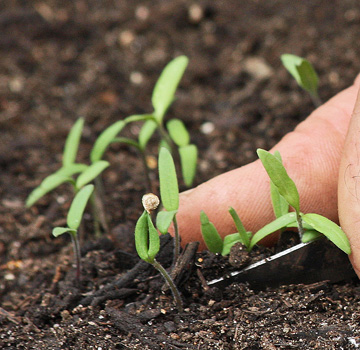
Too much seed being planted results in plants being too close together.
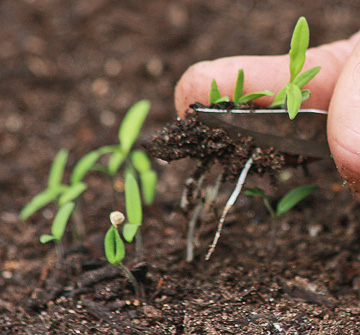
The excess plants must be thinned (removed) or relocated to obtain the optimum distance between mature plants. Size of mature vegetables dictates distance between plants. For instance, larger vegetables, such as broccoli, cabbage, cauliflower, cucumber, eggplant, cantaloupe, okra, pepper, squash and tomato, require 12 to 24 inches or more between plants. Smaller vegetables, such as beans, beets, carrots, lettuce, onions, southern peas, spinach and turnips, require only 1 to 4 inches between plants. Cultural techniques, such as caging or staking, also influence spacing of larger plants.
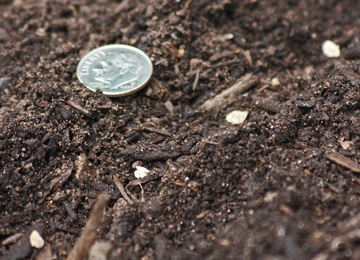
Sow or plant seeds at least two inches apart. When seedlings emerge you can thin them to correct spacing for the crop you are growing. Thin seedlings to the correct spacing for mature plants by cutting off the weakest looking ones at the soil surface and/or transplant the extras to other garden areas.
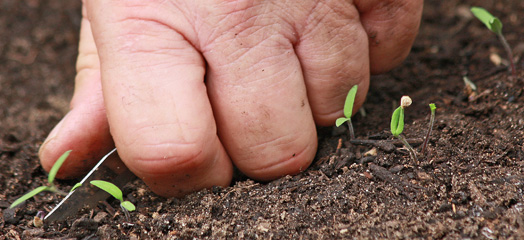
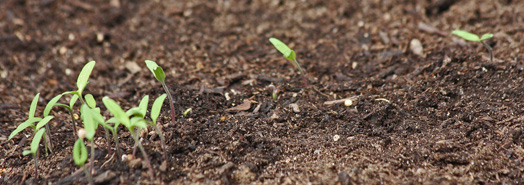
When the seedlings are about three inches high, space them twice as thick as you ultimately want the mature plants to be. After the plants grow to one-half their ultimate size, finish removing the extra plants. For instance, pepper and tomato require 12 to 24 inches or more between plants so the first thinning would leave pepper plants 6 (twice as thick as you ultimately want) inches apart and the tomato plants 12-16 inches apart. The second thinning should leave pepper plants 12 inches apart and tomato plants 24-32 inches apart.
Succession thinning, such as this, avoids loss of stand due to an unexpected plant kill.
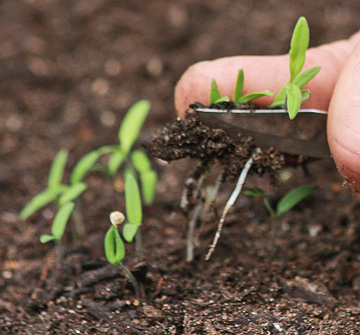
If the intent is to move or transplant the excess seedlings be sure to lift the seedlings or transplants from beneath with a large spoon or trowel. Do not pull them out. Set the seedling or transplant slightly deeper than it was growing in its original location. Firm the soil around young plants very gently to avoid injuring the tender stem and root tissue. Immediately after transplanting, thoroughly water each area planted.
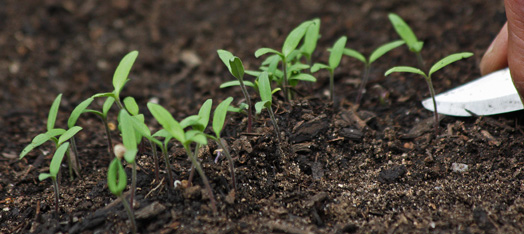
(2) SOIL MOISTURE
Seeds need to absorb moisture before germination and growth can begin.
Water the planting area several days before planting. Farmers refer to this as pre-irrigation. It is much better to plant seed into a moist soil, which immediately stimulates germination, than it is to plant seed in a dry soil and then try to apply adequate moisture for germination --
numerous problems can occur. After seed are planted keep the planting
area moist. Don't crust or harden the top of the planting bed with
direct sprays of water.
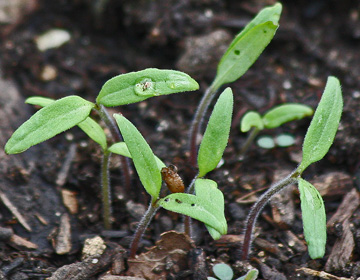
An ideal situation is to maintain uniform moisture and oxygen in the soil. The best method to accomplish this difficult task is by using
drip irrigation. In garden applications, the drip-hose with holes is
laid down the plant row. After seeding, irrigate slowly until seeded area is wet. When using drip irrigation, a system must have the capability to maintain uniformly moist soil near the surface along any row where you wish to germinate seeds. For newly-seeded gardens, the system should be operated only a short time (one hour) every day for a few days (until germination or seed growth begins) to keep the surface
soil from drying out. After seedlings are four to six inches tall, you
should water less frequently (every other day for an hour). Plants loaded with fruit will need to be watered for three hours a day, on every other day. Moist surface soil is desirable only when germinating seed. Mulch around plants one month after plants emerge - don*t pile mulch on plant stems.
If you do not have time to pre-irrigate the soil before planting, use a hoe or other suitable tool to open a very shallow furrow or trench on top of the planting bed and slowly add water to the trench. Do this several times until a large area around and under the trench is thoroughly wet. Carefully scatter the seed in the wetted trench a little thicker than the recommended spacing for the crop you are planting. Then use a rake to slightly cover the seed with soil.
A higher percentage of seed will emerge if the soil surface is not allowed to dry and get hard. It may be necessary to water the germinating seed frequently or to cover the seed row with newspaper or a board to prevent the drying of the soil surface. Sand, compost or peat moss sprinkled over the seed rather than covering with soil will reduce the possibility of soil getting too hard to allow the germinating seed to emerge. If the vegetable plants are to survive, newspaper or boards must be removed when the seedlings just begin to emerge-check every other day.
SEED EMERGENCE
Most seeds (with the exception of lettuce!) do not require light to germinate, but seedlings need full, direct light as soon as they emerge.
Generally, days from planting to emergence for lettuce is 4-6 days; for tomato, 6-12 days; for pepper, 9-14 days.
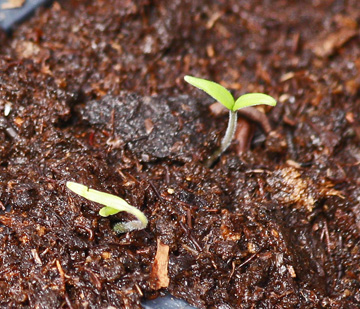
(3) FERTILIZATION
It is VERY important to future growth and ultimate yields that germinating seed IMMEDIATELY have plant-available sources of certain essential nutrient elements. These essential nutrient elements products are sold as Starter Solutions and should be available at-the-seed as germination first begins.
After seedling emergence and during early development, strong, rapid plant growth can be assured by irrigating with a solution of soluble fertilizer (Miracle Gro, Peters 20-20-20, Hasta-Grow, Rapid Grow). Be sure to mix the solution carefully, as instructed on the label.
Before seeding or transplanting, apply 4-6 pounds (cups) of a 50 percent slow-release fertilizer such as 19-5-9 or 15-5-10 per 100 square
feet (10 x 10) of planting area and work it into the soil.
Broccoli, cabbage, cauliflower, collards, kale, lettuce, mustard, spinach, and turnip greens require 1-1/2 to 2 ounces (4 tablespoons) of a 50 percent slow-release fertilizer such as 19-5-9 or 15-5-10 per 10 feet of row 2 weeks after transplanting or 4 weeks after sowing seed.
Flowering annuals require 2 ounces (4 tablespoons) of slow-release fertilizer every 4 to 8 weeks for the life of the plants.
All of this may sound confusing (Why start now when I am still harvesting spring-planted tomatoes?!) and difficult (Most folks have never grown tomatoes and peppers from seed!).
However, if you depend on old, spent plants to produce quality produce in the fall, you are going to be sadly disappointed.
Besides, you need to rid the garden of the HUGE insect population which has been reproducing on your plants. The best control is garbage can!!
With fast-growing, frost susceptible crops such as beans, peas, squash and cucumbers, plant in successions of a week apart so you will have fresh vegetables right up to the first hard frost of late fall.



